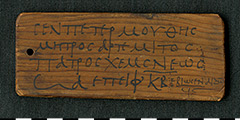SB I 1194 (ÄM 11846)
This small, rectangular wooden tablet is the mummy label of a 96-year-old woman named Senpetermuthes, who lived in Egypt in the 3rd century AD. The mummy label contains the same text in Greek language on both sides, written with ink directly on the wood. The provenance of the mummy label is unknown. Like most of the other mummy label it was probably found in the cemetery in Sohag near the ancient city of Panopolis. The mummy label was bought in Egypt by Rudolph Forrer and arrived in the collection of the Egyptian Museum in Berlin in 1894.
The text on both sides of the mummy label contains first the name of the deceased person: Senpetermuthes. Since the main purpose of the mummy labels was to identify the embalmed corpses to which they were attached, the name of the dead was not sufficient. Too many people could have the same name. For this reason, in the next two lines the mother Artemis and the father Chemsneus were named in order to clearly identify the dead. Striking is the Greek name of the mother – she was named after the goddess of the hunt, although daughter and father had purely Egyptian names. In the last line, the date of death is given, in the typical form of that time, i.e. the year was counted after reigning years of the respective ruler. In this case, it is the 22nd Epeiph (an Egyptian month name) in the 1st year of a ruler, who is not named. Unfortunately, this information is not very helpful. Although we learn that Senpetermuthes died on 16 July, but we cannot say exactly in which year that was. Every ruler had a first year of government, even if he ruled only for a very short period. But the handwriting allows us to date this mummy label to the 3rd century AD.
The special feature of this mummy label is the addition, which was written much smaller in the lower right corner on both sides of the wooden tablet. Here we learn that Senpetermuthes died at the age of 96 years. This even in our time very high age is probably the reason why this additional information has been added to the small free space. It is interesting that the scribe made a many mistakes in these few words. Thus, the word for year, which should actually be ἐτῶν in Greek, was written as αἰδῶν – two mistakes in one word, which, however, may allow conclusions about how the writer has pronounced this word.
Mummy labels appeared from the 1st century AD and remained popular in the following centuries. The mummy-affixed signs were provided with the name of the dead, and occasionally provided further information about the dead, such as the age of the deceased. Occasionally the labels also included religious formulas or freight instructions about transporting the mummy to the place of burial and other details about costs and the like. The mummy labels were not only written in Greek, but also in Egyptian (mostly in Demotic script). These mummy labels were only used for deceased of the lower classes.



